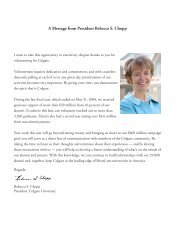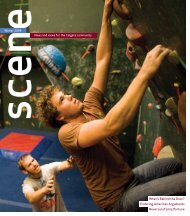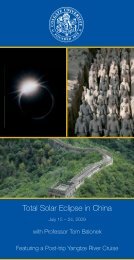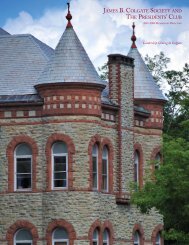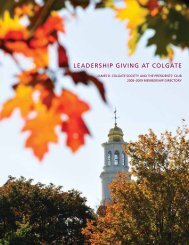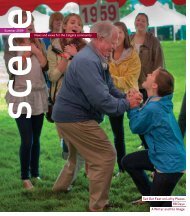101 Things To Do Before You Graduate Living In History ... - Alumni
101 Things To Do Before You Graduate Living In History ... - Alumni
101 Things To Do Before You Graduate Living In History ... - Alumni
You also want an ePaper? Increase the reach of your titles
YUMPU automatically turns print PDFs into web optimized ePapers that Google loves.
computer in the gallery, recorded the<br />
section of the gallery in which it was<br />
located, and then found their 5" by 7"<br />
printed shapes. The shapes were later<br />
distributed to community members at<br />
various locations including Hamilton<br />
Central School, the Palace Theater,<br />
the Poolville Community Center, and<br />
Colgate’s quad. Each shape was signed<br />
by McCollum and provided free of<br />
charge.<br />
Art and art history professor De-<br />
Witt Godfrey coordinated the project<br />
with McCollum, the 2010 Christian<br />
A. Johnson Endeavor Foundation Distinguished<br />
Artist in Residence in the<br />
Department of Art and Art <strong>History</strong>,<br />
through the <strong>In</strong>stitute for the Creative<br />
and Performing Arts.<br />
A team of students and Colgate<br />
staff members contributed to the<br />
Shapes for Hamilton project with<br />
community research, distribution<br />
planning, and setting up the exhibition.<br />
“Each of his creations is unique,<br />
yet they remain remarkably similar<br />
to one another, like us humans,”<br />
explained Shapes staff member Gabe<br />
Rosen ’12, a studio art major.<br />
Although McCollum has used<br />
the shapes system in other projects,<br />
this was the first time he distributed<br />
individual shapes to each member of<br />
a community. Shapes can now be seen<br />
Can I have my shape, please? A Hamilton resident picks up her own individual “shape,” created<br />
by artist Allan McCollum, from art professor DeWitt Godfrey, who invited McCollum<br />
to bring his Shapes Project to town. McCollum can produce more than enough unique twodimensional<br />
shapes for every person on the planet. <strong>Before</strong> the shapes were given out, they<br />
were displayed in Little Hall’s Clifford Gallery.<br />
Andrew Daddio<br />
Andrew Daddio<br />
around town, hanging in the windows<br />
of homes, in professors’ offices,<br />
and even in school lockers at Hamilton<br />
Elementary.<br />
Two receive Schupf/Lorey<br />
Senior Art Prize<br />
Seniors Kelly Boyle and Emily Rawdon<br />
received the 2010 Schupf/Lorey<br />
Senior Art Prize, which, since 2007, has<br />
been awarded for outstanding work<br />
as identified by Paul Schupf ’58 and<br />
Robert McVaugh, professor of art and<br />
art history.<br />
Boyle, a native of New Hampshire,<br />
was an art and art history major and<br />
an Islamic studies minor. Her ensemble<br />
of four strikingly inventive video<br />
pieces, Story of Some Kind, explores<br />
personal and media imagery in the<br />
context of American discomfort with<br />
ambiguity.<br />
Rawdon, daughter of Dick Rawdon<br />
’65, was a double major in art and art<br />
history and theater from Kentucky.<br />
Her photographic installation Usual<br />
Flow-voids of the Circle of Willis are<br />
Preserved explores the psychic mingling<br />
of euphoria and fear associated<br />
with epileptic seizures. <strong>In</strong> August, she<br />
will enter the School of the Art <strong>In</strong>stitute<br />
of Chicago.<br />
“Professor McVaugh and I worked<br />
long and hard to choose these two<br />
first-class art works. Owing to the<br />
overall high quality of this year’s<br />
senior art exhibition, several other<br />
entries might have been chosen,” said<br />
Schupf, who expressed special thanks<br />
to Evan C. Lorey ’10 for his gift that allowed<br />
Colgate to award an additional<br />
prize this year.<br />
The awards were given at the<br />
senior awards convocation in<br />
Memorial Chapel on Saturday, May<br />
15. See a full list of award recipients at<br />
www.colgate.edu.<br />
Poetry that matters<br />
Her voice was characteristically<br />
scratchy and barely louder than a<br />
whisper. Yet, true to form, Louise<br />
Glück, the Pulitzer Prize–winning lyric<br />
poet, held her audience spellbound for<br />
45 minutes as she read nine poems<br />
from her latest collection, A Village<br />
Life, at the end of March.<br />
Glück received the Pulitzer in 1993<br />
for The Wild Iris, her sixth of 11 books<br />
of poems. Early in her career, she also<br />
authored Proofs & Theories, a collection<br />
of essays on poetry that received<br />
the PEN/Martha Albrand Award<br />
for First Non-Fiction. Presently, she<br />
teaches at Yale University.<br />
Pulitzer Prize-winning lyric poet Louise<br />
Glück reads from her latest collection,<br />
A Village Life.<br />
After decades of writing with<br />
a minimalist’s precision, Glück<br />
changed course for the poems in her<br />
latest collection, using language that<br />
she characterized as “more relaxed,<br />
even gawky.” Nonetheless, the poems<br />
she read included the “punches<br />
to the gut” described in her introduction<br />
by English professor Peter<br />
Balakian. Earlier in the day, she spoke<br />
to his Post-WWII American Poetry<br />
class.<br />
Scott Reu ’13, who reads his poetry<br />
at open mics and is a member of the<br />
student group Poetically Minded,<br />
came to the reading eager to ask a<br />
question that, he said, led his father<br />
to burn reams of his own early<br />
works. Reu wanted to know: “How<br />
can writers, especially younger ones,<br />
distance themselves enough from<br />
personal experience to create poetry<br />
that really matters?” The question<br />
was especially apropos, not only for<br />
the only American poet who has<br />
twice served as judge for the prestigious<br />
Yale Series of <strong>You</strong>nger Poets,<br />
but for one whose work addresses<br />
such universal issues of the human<br />
condition as being young, coming<br />
of age, and love affairs beginning or<br />
ending.<br />
“There’s a difference between the<br />
circumstantial and the intensely<br />
personal,” Glück said. “A dramatic<br />
breakup with a lover can make a<br />
great poem, but experience has to<br />
undergo a transformation. It can’t<br />
simply be decanted onto the page.”<br />
Reu was encouraged. “Her<br />
response set my mind to work,” he<br />
said. “I am astonished that a single<br />
answer to a single question could<br />
have such an impact on the way I<br />
think about poetry.”<br />
News and views for the Colgate community<br />
17<br />
Brooke Ousterhout ’10



